Blackberry Q10 Review
13:26
Take heart BlackBerry diehards, your day is finally here. The BlackBerry Z10 was just a warm up and a promise to the QWERTY faithful that their device would come. The BlackBerry Q10 runs the all new BlackBerry OS 10.1, based on bulletproof QNX, and it's wildly modern compared to the OS on the BlackBerry Curve and Bold. And yes, it has a hardware QWERTY keyboard that won't let you down. Throw in a 3.1" AMOLED touch screen and you've got the Q10. The internals are identical to the touch screen slate BlackBerry Z10, and though the hardware can't compete with the most powerful Android phones, it doesn't need to because the OS is optimized for the hardware inside (much like Windows Phone and the iPhone are highly optimized for specific hardware). The phone has a 1.5GHz dual core Qualcomm Snapdragon CPU, 2 gigs of RAM and 16 gigs of internal storage. The BlackBerry Q10 will be available on all major US carriers and on many carriers overseas. Here in the US at launch, it's $199 with contract ($99 down plus $20 monthly payments on the newly contract-less T-Mobile).
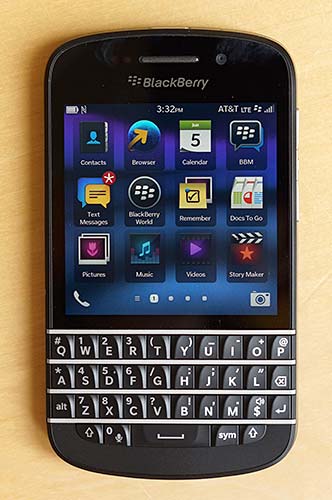
The OS and basic navigation work just the same as on the BlackBerry Z10, so we won't go into great detail in this review. The OS supports multi-tasking via active panes (small windows that tile across the multi-tasking screen), and it has several screens for the app launcher (app icons). BlackBerry Hub is your unified inbox for all notifications from emails to texts, to missed calls and alarms. It's easy and intuitive and you needn't leave the Hub when replying to emails, social networking messages and texts. In fact, there are neither icons nor a separate app for your various email accounts, though there is an SMS/MMS icon. Twitter, Facebook, LinkedIn and Foursquare are preloaded. Box and Dropbox are pre-loaded as is BlackBerry Maps (not the strongest mapping and navigation solution we've seen), a shortcut to the YouTube mobile site and Documents to Go for mobile MS Office compatible work. The OS comes with a file manager, PIM apps that can sync with MS Exchange and other services like Google, POP3/IMAP/Exchange, weather, a clock, calculator, Adobe Reader, a games portal and a compass.
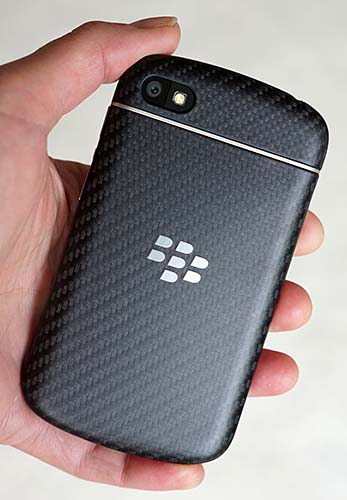
The BlackBerry Q10 has dual band WiFi 802.11b/g/n, Bluetooth 4.0, NFC and a GPS with digital compass. It has a rear 8MP camera with an LED flash (the same as the Z10) and HDR mode that comes courtesy of OS 10.1. BlackBerry World is your one stop shop for apps, music and video. As we noted with the BlackBerry Z10, the app selection doesn't yet come close to competing with iTunes, Google Play for Android and even the Windows Phone app store. The OS and ecosystem are very young, and we hope to see more apps as time progresses, though this in part depends on how many folks buy OS 10 devices (developers need a reason to make apps, after all). Still, some popular apps are here like Skype, MLB at Bat, Angry Birds, Google Talk (a RIM app), TuneIn Radio and Wisepilot (navigation).
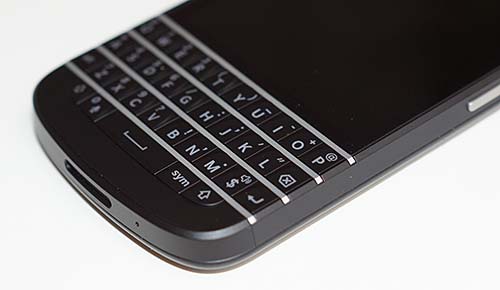
Design and Ergonomics
The Q10 looks like a modern interpretation of older QWERTY smartphones. I wouldn't call it a stunning phone (it may be nearly impossible to make a phone with a hardware keyboard look uber-sexy), but the black model's carbon fiber back appeals to the car geek in me and it's strong too. The phone's face has a clean and modern look with attractive metal strips between the key rows that make it easier to find your place on the keyboard in the dark. The phone isn't very thin, but the hardware keyboard and removable battery don't allow for impossible thinness. The back cover slides off to reveal the removable 2100 mAh battery, micro SIM card slot and micro SDXC card slot.
The metal volume rocker with center action button is the same as the Z10's, and it's easy to locate by touch but stiff enough that we didn't activate it by accident. The power/sleep button is up top as is the 3.5mm combo audio jack. Both the micro USB and micro HDMI ports are on the left side. The 2MP front camera and notification LED that blinks urgent red when messages and alerts are waiting sit above the display and the speaker is on the bottom edge. Our black model's back is grippy but not sticky and feels good in hand. The phone is relatively small compared to today's gargantuan smartphones and the Q10 is a bit shorter than the Z10. The Q10 feels sturdy and the sides are reinforced with metal underneath the plastic.
Calling and Data
BlackBerry phones are typically excellent voice phones, and the Q10 on AT&T didn't disappoint. Our call recipients thought we were calling from a landline phone and likewise incoming voice was clear with average volume by cell phone standards. This is an excellent phone for calls. Data speeds according to speedtest.net were in line with today's LTE 4G phones and our BlackBerry Q10 averaged 25Mbps down and 16Mbps up on AT&T's LTE network in the Dallas metroplex. The phone played nicely with our Jawbone and Motorola Bluetooth headsets and our BMW's built-in Bluetooth for calls.
Keyboard
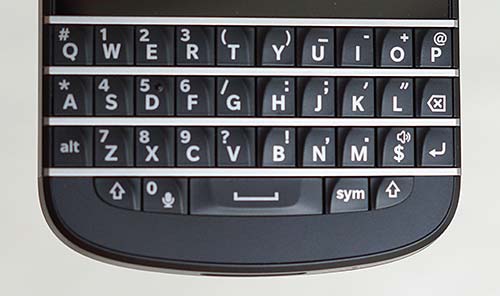
Gone are the trackballs and optical nav pads found on older BlackBerry smartphones. The touch screen replaces them, though purists will likely lament the further travel to the screen vs. the nav pad. I have no qualms with the thoroughly modern touch screen and I suspect the days of auxiliary navigation elements have passed. The keyboard is pure joy for hardware keyboard lovers and it maintains the sculpted waterfall keys we loved years ago on the BlackBerry Bold 9900. The tactile keys make it easy to tell when you're on target and it's clear if you've wandered from your desired key. The usual BlackBerry keyboard shortcuts live on: double press the space bar for a period, for example. BlackBerry OS 10.1 brings a host of hardware keyboard tricks including typing "tweet" followed by a message to send a new tweet, and "BBM Joe Blow" to start a BBM to Joe. The keys are tactile and clicky, and for those who love their hardware keyboards (some 70 million strong use BlackBerry phones worldwide), it won't disappoint.
Display
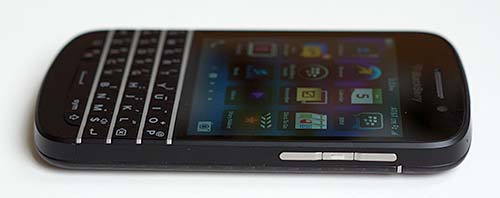
At 328 PPI, the Q10's display has sufficiently high pixel density that text and graphics always look very sharp, even though the 720 x 720 resolution won't win any competitions with current smartphones. The challenge is the 3.1" size: OS icons and text are reasonably easy to see but text in web pages and documents is tiny. That's the price you pay for the hardware keyboard that consumes much of the front face real estate. Even with mobile sites, I often had to pinch zoom to make text easy to read and desktop sites have absolutely tiny text. As with BlackBerry smartphones of old, be prepared to zoom when viewing web pages. Email and text messages are easy to read since the OS handles font scaling, though you'll have to scroll often to read through a medium length email. The Super AMOLED display has very good color saturation and contrast and it's viewable outdoors.
Horsepower and Performance
In an Android phone review, this is where we include many different benchmarks and analyze speed in detail. As with Windows Phone, that's not necessary here, not just because myriad benchmark programs don't yet exist for BlackBerry OS 10, but also because the phone's software is completely optimized to perform well on the hardware. This is a quick and responsive phone and the UI maintains speed after several days of uptime. The active panes are here, just as with the BlackBerry Z10 running OS 10, and these are miniaturized windows where your running apps sit when minimized. Tap one and it runs full screen with no significant delay, just where you left off. The OS handles memory, so some apps may not update when running minimized as active panes, but if you have 9 or fewer running, they generally do update. The thoroughly modern webkit web browser with Adobe Flash is very fast and is competitive with other platforms in terms of speed and website compatibility.
Battery Life
Unlike the BlackBerry Z10 that launched with just OK runtimes that improved with OS updates, BlackBerry clearly focused on battery life with the Q10 knowing it had to compete with the OS 7 BlackBerry phones it supplants. Thanks to the small display, relatively undemanding CPU and a large 2100 mAh battery, the phone delivers impressive runtimes. We routinely managed two days on a charge with moderate use that included Facebook, Twitter and 3 email accounts updates, 45 minutes of voice calls, 30 minutes of streaming HTML5 video via YouTube and an hour of web browsing each day.
Camera
Like the BlackBerry Z10, the Q10 has a 2MP camera on the front and an 8MP camera with LED flash, backside illuminated sensor and a fast f/2.2, five element lens on the rear. Though BlackBerry OS 10.1 introduces HDR shooting for better high contrast exposure, the camera is hobbled by a simplistic UI with few controls. Yes, the iPhone has few camera settings and controls, but Apple has a way of making users forgive them because photos and videos come out looking great without having to fiddle endlessly with settings. With the BlackBerry Q10 camera, I often feel that its good hardware fails to meet the iPhone 5, Samsung Galaxy S3 and Nokia Lumia 920 challenge because the software isn't as good as it could be and I'm not allowed to tweak settings to help it.
With good, even lighting, photos are sharp and colorful. With stark outdoor sunlight or poor indoor lighting, HDR really helps bring out detail in dark areas. Video stabilization is decent but not nearly as good the optical image stabilization on the Nokia Lumia 920. That said, with proper lighting, the BlackBerry Q10 captures sharp and colorful shots and fairly smooth 1080p video. And it's certainly leaps and bounds ahead of Curve and Bold cameras. If you're upgrading from an older BlackBerry model, you'll be in heaven.


0 comments